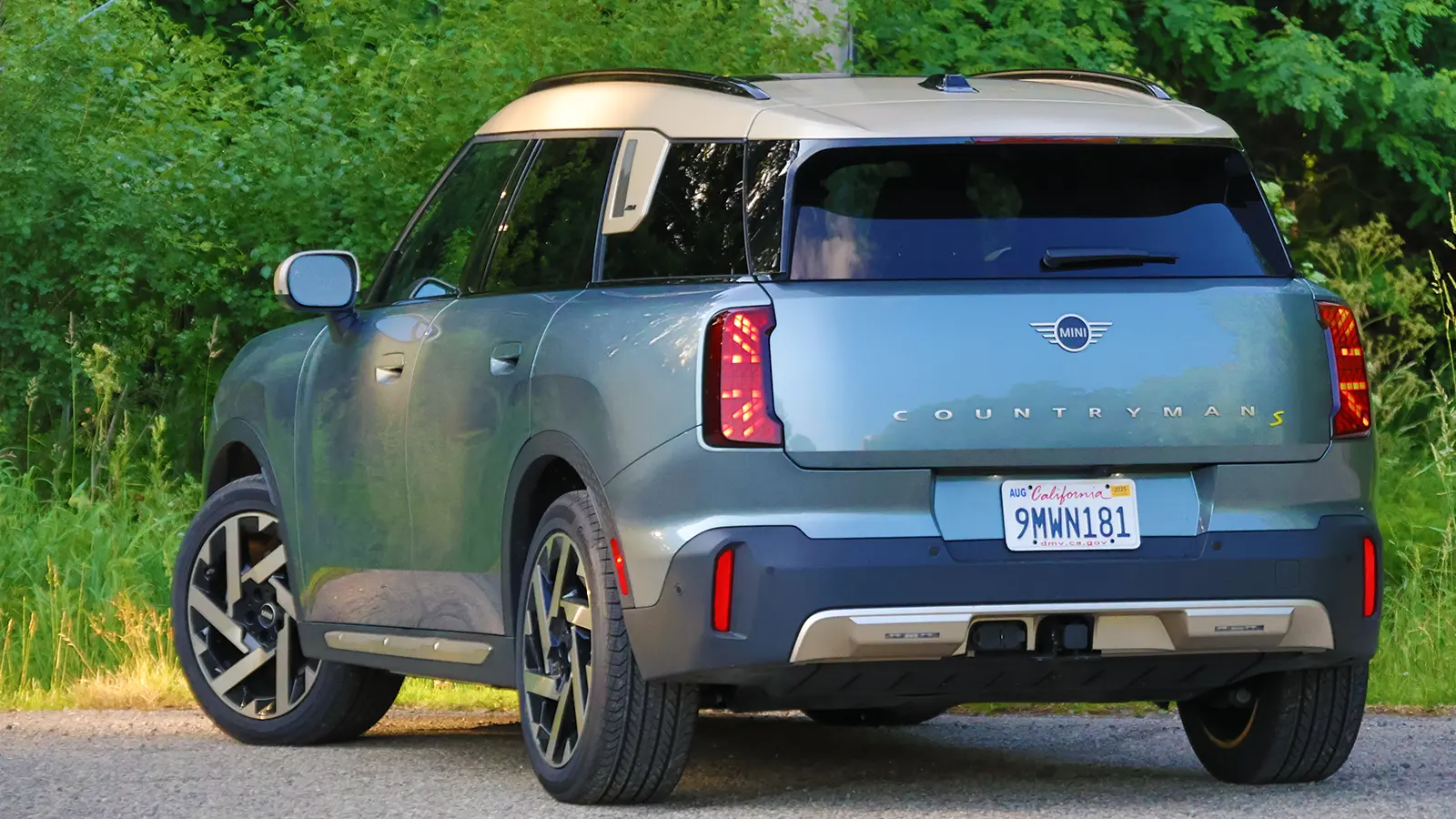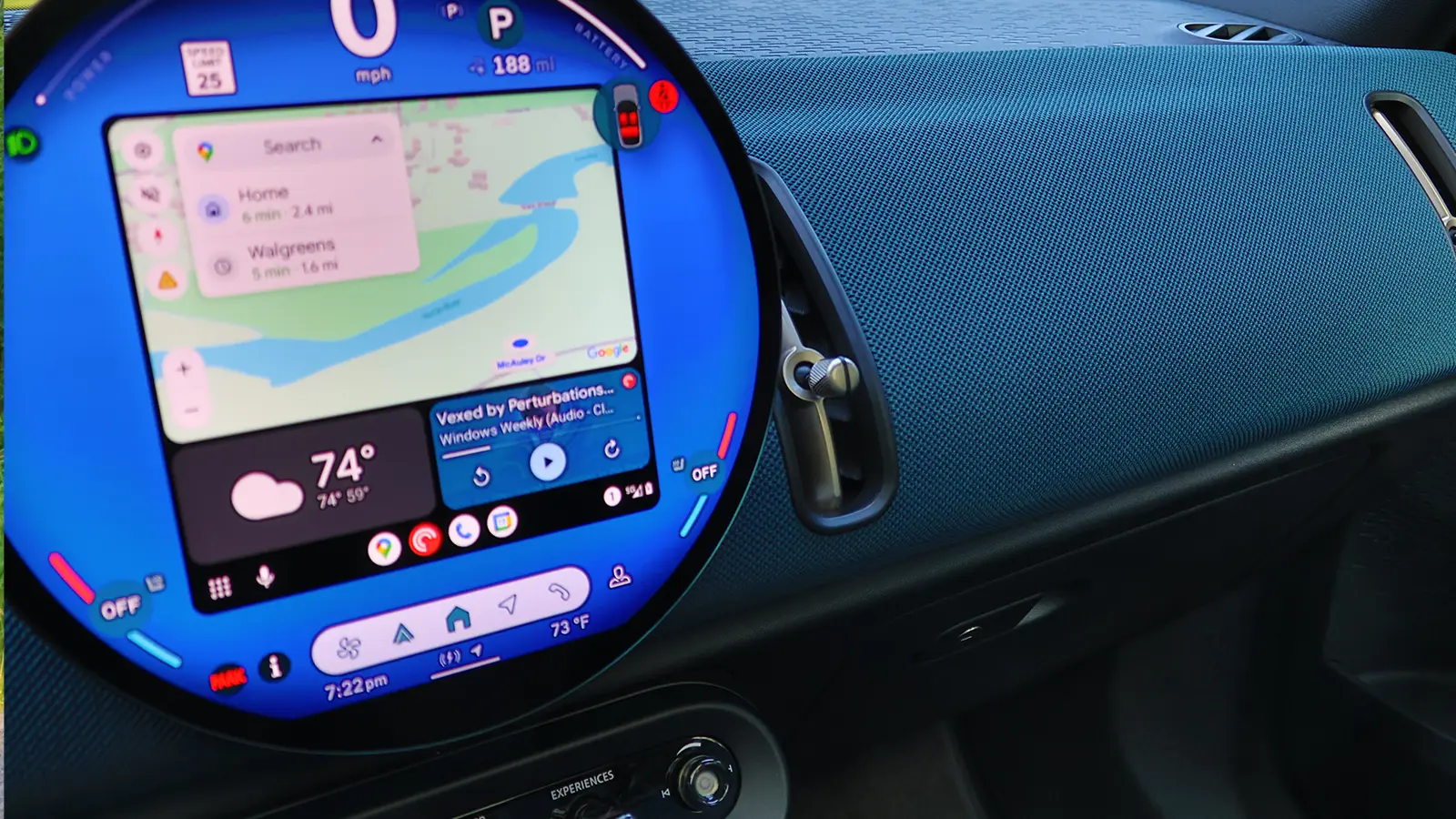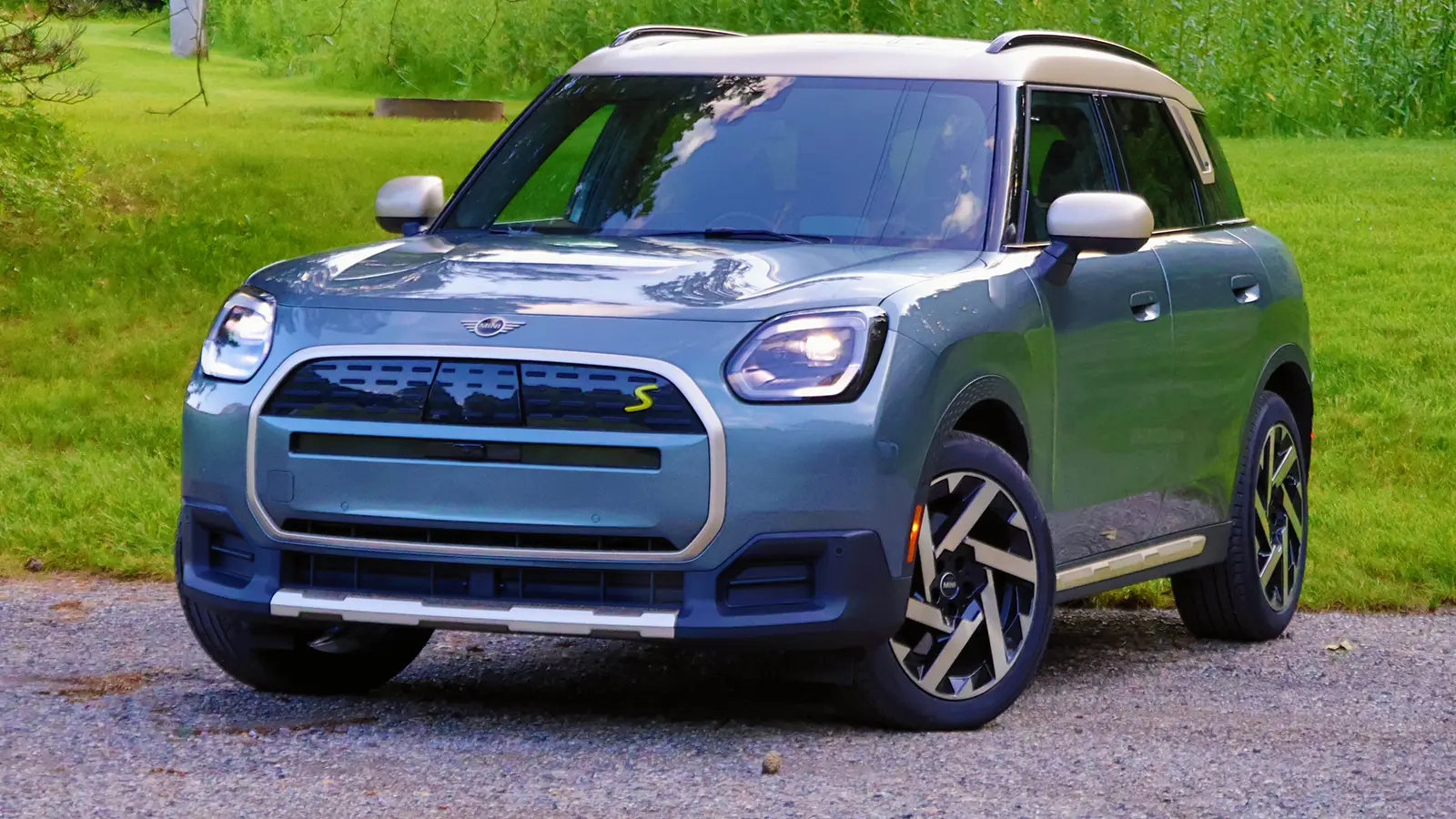Lightning in a Bottle?
By modern vehicle standards, especially here in the U.S., the Mini Countryman is compact. But compared to the classic pre-2000 Minis, it’s absolutely huge. For 2025, the third-generation Countryman got a complete redesign, and the last generation's plug-in hybrid has been replaced by a fully battery-electric version with the same name: the Mini Cooper Countryman SE ALL4.
I got to spend a week with it, including a couple of extended drives across Michigan and lots of charging. Since we've reviewed the Mini Countryman before, this will focus on real-world range and charging, specifically using the Vortex NACS-CCS charging adapter.
🔥 Quick Takeaways
- ⚡ Power & Performance: 0-60 mph in 5.2 seconds (tested)
- 🔋 Real-World Range: Achieved up to 213 miles highway driving (EPA-rated at 212 miles)
- 📏 Cargo Space: Practical 25 cubic feet of cargo capacity
- 🔌 Battery & Charging: 66.5 kWh battery; 110 kW peak charging rate
- 💲 Charging Infrastructure: Compatible with Tesla Superchargers via Vortex NACS-CCS adapter

Still a Mini, Just More SUV
I had the Countryman the week after I tested the latest version of the standard Mini, now called the Hardtop. The Cooper S Hardtop has retained a more traditional Mini vibe with round headlamps and a bubbly personality. The Countryman, in contrast, has diverged a bit. It still has Mini DNA, but it's taken on a blockier look, in keeping with its positioning as the SUV of the lineup, and it looks like it's spent some time hitting the weights at the gym.
Personally, I prefer the classic look, but if you need the extra space for carrying adult passengers or kids in car seats, the Countryman is probably a better option. At 5-foot-10, I can just barely sit behind the driver in the Hardtop. I was much more comfortable in the Countryman.
Inside, the layout of the two models was identical, apart from a higher seating position in the Countryman. Most controls are integrated into a 9.4-inch circular touchscreen, including, unfortunately, the climate controls. This setup proved distinctly finicky to use while driving, and given that the Countryman’s arrival in my driveway coincided with the beginning of a major heatwave, it was annoying when adjusting the air conditioning. Fortunately, the most important driver information was also displayed in the standard head-up display projected directly in front of me.
EV vs. ICE: Comparing the Two Minis
I’m fortunate to drive a lot of electrified vehicles, and it was interesting to compare the experiences of driving two related vehicles back-to-back. Sadly, for those of us who like the old-school three-pedal driving experience, Mini no longer offers manual transmissions in North America. While the 201-horsepower turbo four in the Hardtop was fun, its dual-clutch automatic transmission is not ideal for most quick launch situations.
While I miss the sound of a great engine when I go electric, I love the instantaneous response, and the Countryman SE does respond. In my timing, it hit 60 mph on a slight uphill grade in just 5.2 seconds, 0.2 seconds quicker than Mini’s claim. Squeeze the accelerator, and it just goes.
Sadly, I accumulated most of my miles on highways, including trips to visit automotive benchmarking firm Caresoft in Livonia, Michigan, the Ford BlueOval Battery Park in Marshall, Michigan, and the LG Energy Solution battery plant in Holland, Michigan. All three of these trips had a lot to do with EVs and batteries, making it appropriate that I had an EV to drive.
Charging at Home: Easy and Reliable
From my home in Ypsilanti, the Caresoft shop was about a 70-mile round trip. The Countryman SE has a 66.5-kilowatt-hour (kWh) battery pack and an EPA-estimated range of 212 miles. I topped off the battery at home before and after that trip using an Autel 9.6-kilowatt (kW) Level 2 charger. I’ve been using this charger for a couple of years now, and it has worked reliably with plug-in hybrids and EVs from many manufacturers. The version I have is plugged into a standard NEMA 14-50 outlet in my garage, which limits it to pulling 40 amps from the 50-amp/240-volt circuit, though that's enough for a full overnight charge.
Not sure which EV fits your lifestyle best? Try our interactive guide: EV Matchmaker
Over the weekend, as the temperatures got into the mid-90s with high humidity, we decided it was time to cool off with a trip to the lake. I put a seat cover in the back for the dog and loaded an inflatable paddleboard, a couple of beach chairs, and an assortment of other stuff in the 25-cubic-foot cargo area. The prior weekend, with the much more limited volume of the Hardtop, we had to leave the dog at home and fold down the back seats to carry the same amount of stuff.
On Monday morning, I headed out early to visit the Ford battery plant, a 158-mile round trip. I wanted to complete the trip without charging, even with the heat wave in full swing and temperatures topping 80 degrees with nearly 80% humidity by 6:30 a.m. Since I left the Countryman plugged in overnight, I went into the menu, set up a departure time, and turned on pre-conditioning to get the cabin temperature to 68 degrees before unplugging.
Even after sitting in the hot sun for several hours while touring the plant site, the air conditioning got the temperature back to a comfortable level quickly, and I managed to get home with 55 miles of range left, which would work out to 213 miles of range. Considering that this was almost all highway driving at a relatively steady 75 mph (what Mini calls Core driving mode) with the air conditioning on the whole time, that’s an impressive performance. I again got a full charge at home overnight, one of the best benefits of driving an EV.

Planning a Road Trip: Public Charging and Adapters
Tuesday was the big test for the Countryman. The trip to the LGES factory was 165 miles, and the temperature was just as hot as Monday. Before the trip, I spent some time with Google Maps and A Better Route Planner determining where I should stop to charge, since the Countryman’s range would only cover a little less than two-thirds of the round-trip distance. I brought along the Vortex NACS-CCS charging adapter Lectron had recently sent me for evaluation. Currently, there are about 20,000 Tesla Superchargers across North America that support charging for non-Tesla EVs. These are all V3 and above Superchargers; the older V2 chargers are not compatible with other brands of EV.
With my Vortex in the door pocket, my plan was to drive to the LG plant in Holland for the factory tour and then partway back to Grand Rapids. There is a Tesla Supercharger station just off I-96 on the south side of Grand Rapids, which I found easily. The total distance from my home to LG and back to the Superchargers was 194 miles, and I arrived with 20 miles of range remaining. On the 30-mile run from Holland to Grand Rapids, I decided it was getting a bit tight. I wanted to leave myself some slack in case I had any issues with the Superchargers, so I dropped my cruise control speed to 70 mph and raised the AC to 72 degrees, which bought me an extra 7 miles of range.
Charging Frustrations
The Tesla station was a newer location that featured the latest V4 Superchargers, but still used older V3 cabinets. The new dispensers have longer cables than the older V3 units, which means they can reach the charge ports on non-Tesla EVs better, as they can be anywhere on the vehicle. With V3 units, many vehicles like the Mini need to be parked in an adjacent stall to reach the port on the right rear corner.
Charging with an adapter is generally simple: Pull the cable out of the dispenser, plug it into the adapter, and then plug the adapter into the car. Then, use the app to start and manage the charging session. Unfortunately, after three attempts on two different chargers, I consistently got a communications error and charging never started. Since this was my first time using V4 dispensers, I’m assuming there was a software mismatch between the dispenser and the Mini.
I did some more searching and found a Shell Recharge location about 6 miles back in the wrong direction, but it was the closest DC fast-charger to my location with only 20 miles still showing for range. The Countryman is on the low end of current generation EVs in terms of charging speed, and sadly, the Volta chargers at the Shell Recharge at an outlet mall were only 50-kW units, and since they were new, the card readers weren’t yet working.
That meant I had to download the Shell app and create an account while standing there, sweating like mad in 93-degree heat and high humidity. It took several attempts to get the account creation process to not fail at the final step. Once I finally got the charge going, I strolled across the parking lot with my laptop to a Starbucks, had an iced tea, and answered some emails for half an hour.
By the time I got back to the car, I had more than enough range to get to a General Motors/EVgo Flying J Station in Lansing, 55 miles away. GM and EVgo are installing 350-kW chargers at 500 Flying J truck stops across the country, all with canopies over the chargers and all the usual Flying J amenities. I plugged in there, and the charging speed quickly jumped to 110 kW before settling into the mid-90s.
Because of the power levels being pushed through fast-charging cables, they are typically liquid-cooled. After about 15 minutes, the Countryman was at 59% charge when the charger stopped and showed an error that it was out of coolant, something I’ve never seen before. Fortunately, that was more than enough to get me the 84 miles back to Ypsilanti.
Ready to dive into EV ownership? Explore our comprehensive guide: Buyer's Guide
When I got back to Ypsi, I decided to go to my local Supercharger, which has worked reliably with the Vortex adapter in the past. I got there with about 40 miles of range left, but at 5 p.m., nine of the twelve stalls were taken, and those that were available reached the Mini's charge port due to the shorter V3 cables.
After waiting about five minutes, one of the Teslas left, and I was able to back the Countryman in close enough to reach the cable from the adjacent stall. I did the usual procedure of attaching the adapter to the cable, plugging it into the car, and starting the session from the app. Within 30 seconds, electrons were flowing. Unfortunately, it was only running about 80 kW, which may have been because eight other vehicles were charging at the same time. I let it go for about five minutes and then stopped the session in the app, unplugged everything, and went home to let the Mini charge overnight before dropping it off at the airport for pickup on Wednesday morning.
Final Thoughts
As is often the case when traveling with an EV in America, charging on the road can be a frustrating experience. It has definitely gotten better in the last two years, but even the industry leader, Tesla, still has issues sometimes. I got home about 90 minutes behind schedule, due to my charging issues. In retrospect, I probably should have charged at a Supercharger station closer to the LGES factory (there's a Supercharger station in Zeeland, Michigan, just north of Holland), but I wanted to see how far I could go on a charge.
Despite all that, the Mini Countryman SE ALL4 acquitted itself well, given the speed I was driving and the heat. It averaged 3.3 miles/kWh over 500 miles of mostly highway driving with the air conditioning cranked up, proving it can easily meet or exceed its 212-mile EPA rating. However, it’s probably not the best road trip EV, given its relatively modest range and slow “fast” charging, but it’s an excellent choice as a daily driver.
I also recommend the Lectron Vortex NACS-CCS adapter. It’s available online for $200 or less, and so far, except for a mismatch between the Mini and the V4 Supercharger, it has worked flawlessly.
⚡ More EV and Hybrid Reviews ⚡
2024 BMW i4 xDrive40 Road Test
BMW enhances the all-electric i4 with an all-wheel-drive version, boosting performance and practicality for 2024.
Read More ➜
2024 Chevrolet Blazer EV Road Test
We put Chevy’s electric Blazer through its paces to test performance, comfort, and range in everyday driving.
Read More ➜
2024 Hyundai Ioniq 5 Road Test
Hyundai’s award-winning Ioniq 5 EV undergoes testing to see how it holds up in terms of range, style, and practicality.
Read More ➜









